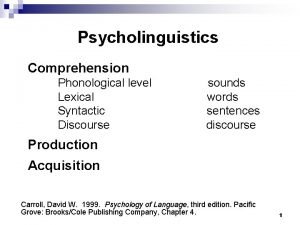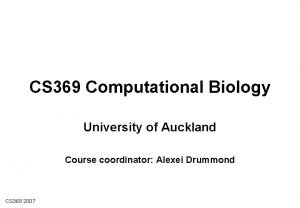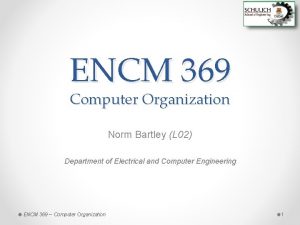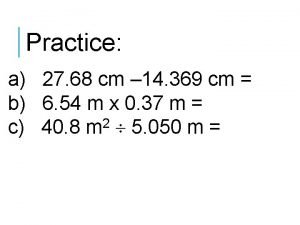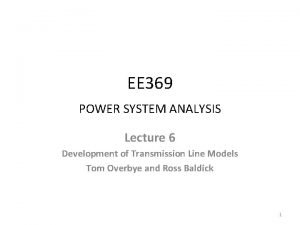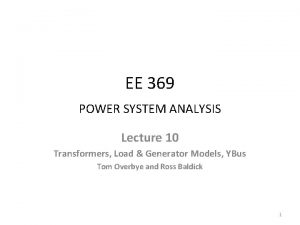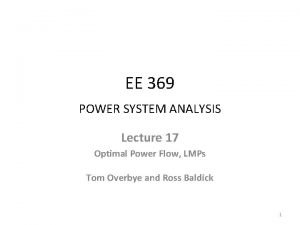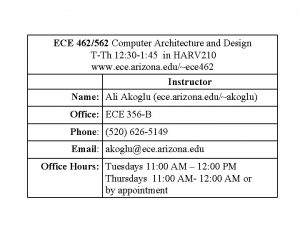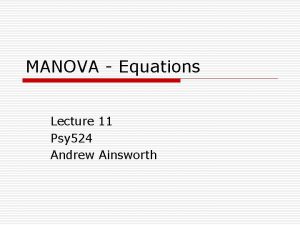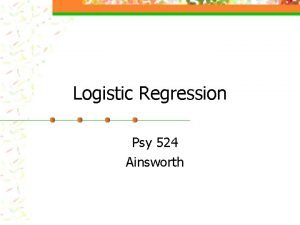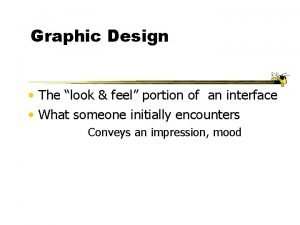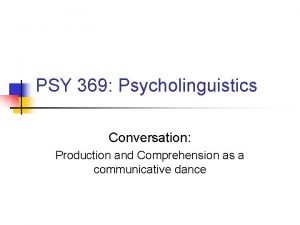PSY 369 Psycholinguistics Language Production Comprehension Conversation Dialog












































- Slides: 44

PSY 369: Psycholinguistics Language Production & Comprehension: Conversation & Dialog

Conversational interaction n n n n ABBOTT: Super Duper computer store. Can I help you? COSTELLO: Thanks. I'm setting up an office in my den, and I'm thinking about buying a computer. ABBOTT: Mac? COSTELLO: No, the name is Lou. ABBOTT: Your computer? COSTELLO: I don't own a computer. I want to buy one. ABBOTT: Mac? COSTELLO: I told you, my name is Lou. ABBOTT: What about Windows? COSTELLO: Why? Will it get stuffy in here? ABBOTT: Do you want a computer with windows? COSTELLO: I don't know. What will I see when I look in the windows? ABBOTT: Wallpaper. COSTELLO: Never mind the windows. I need a computer and software. ABBOTT: Software for windows? COSTELLO: No. On the computer! I need something I can use to write proposals, track expenses and run my business. What have you got? ABBOTT: Office.

Conversational interaction n n n n COSTELLO: Yeah, for my office. Can you recommend anything? ABBOTT: I just did. COSTELLO: You just did what? ABBOTT: Recommend something. COSTELLO: You recommended something? ABBOTT: Yes. COSTELLO: For my office? ABBOTT: Yes. COSTELLO: OK, what did you recommend for my office? ABBOTT: Office. COSTELLO: Yes, for my office! ABBOTT: I recommend office with windows. COSTELLO: I already have an office and it has windows!OK, lets just say, I'm sitting at my computer and I want to type a proposal. What do I need? ABBOTT: Word. COSTELLO: What word? ABBOTT: Word in Office. COSTELLO: The only word in office is office. ABBOTT: The Word in Office for Windows.

Conversational interaction n n n n COSTELLO: Which word in office for windows? ABBOTT: The Word you get when you click the blue "W. ” COSTELLO: I'm going to click your blue "w" if you don't start with some straight answers. OK, forget that. Can I watch movies on the Internet? ABBOTT: Yes, you want Real One. COSTELLO: Maybe a real one, maybe a cartoon. What I watch is none of your business. Just tell me what I need! ABBOTT: Real One. COSTELLO: If it’s a long movie I also want to see reel 2, 3 and 4. Can I watch them? ABBOTT: Of course. COSTELLO: Great, with what? ABBOTT: Real One. COSTELLO; OK, I'm at my computer and I want to watch a movie. What do I do? ABBOTT: You click the blue "1. ” COSTELLO: I click the blue one what? ABBOTT: The blue "1. ” COSTELLO: Is that different from the blue "W"? ABBOTT: The blue 1 is Real One and the blue W is Word. COSTELLO: What word?

Conversational interaction n n n ABBOTT: The Word in Office for Windows. COSTELLO: But there are three words in "office for windows"! ABBOTT: No, just one. But it’s the most popular Word in the world. COSTELLO: It is? ABBOTT: Yes, but to be fair, there aren't many other Words left. It pretty much wiped out all the other Words. COSTELLO: And that word is real one? ABBOTT: Real One has nothing to do with Word. Real One isn't even Part of Office. COSTELLO: Stop! Don't start that again. What about financial bookkeeping you have anything I can track my money with? ABBOTT: Money. COSTELLO: That's right. What do you have? ABBOTT: Money. COSTELLO: I need money to track my money? ABBOTT: It comes bundled with your computer. COSTELLO: What's bundled to my computer? ABBOTT: Money.

Conversational interaction n n COSTELLO: Money comes with my computer? ABBOTT: Yes. No extra charge. COSTELLO: I get a bundle of money with my computer? How much? ABBOTT: One copy. COSTELLO: Isn't it illegal to copy money? ABBOTT: Microsoft gave us a license to copy money. COSTELLO: They can give you a license to copy money? ABBOTT: Why not? THEY OWN IT! (LATER) COSTELLO: How do I turn my computer off? ? ABBOTT: Click on "START".

Conversational interaction “the horse raced past the barn” “the kids swam across the river” Conversation is more than just two side-byside monologues.

Conversational interaction “The horse raced past the barn” “Really? Why would it do that? ” Conversation is a specialized form of social interaction, with rules and organization.

Conversation n Fillmore (1981) “The language of face-to-face conversation is the basic and primary use of language” (pg. 152) n So all instances of language usage can (should) be compared to conversation n What is the impact of the presence or absence of different features of face-to-face conversation?

Conversation n Herb Clark (1996) n Face-to-face conversation - the basic setting n Features Immediacy n Co-presence Visibility Audibility n Instantaneity n n n Medium n n n Evanescence Recordlessness Simultaneity Control n n n Extemporaneity Self-determination Self-expression Other settings may lack some of these features n e. g. , telephone conversations take away co-presence and visibility, which may change language use

Conversation n Herb Clark (1996) n Joint action n Autonomous actions n n Things that you do by yourself Participatory actions n n n Individual acts only done as parts of joint actions People acting in coordination with one another n Doing the tango n Driving a car with a pedestrian crossing the street The participants don’t always do similar things

Conversation n Herb Clark (1996) n Speaking and listening n Traditionally treated as autonomous actions n n Contributing to the tradition of studying language comprehension and production separately Clark proposed that they should be treated as participatory actions

Conversation n Herb Clark (1996) n Speaking and listening n Component actions in production and comprehension come in pairs Speaking Listening n A vocalizes sounds for B n B attends to A’s vocalizations n A formalizes utterances for B n B identifies A’s utterances n A means something for B n B understands A’s meaning n The actions of one participant depend on the actions of the other

Conversation n Herb Clark (1996) n Arena’s of language use - places where people do things with language n Meaning and understanding n n Establishing Common Ground Identifying participants Layers Conversation is structured

Meaning and understanding n Common ground n n Common ground is necessary to coordinate speaker’s meaning with listener’s understanding Knowledge, beliefs and suppositions that the participants believe that they share n n n Members of cultural communities Shared experiences What has taken place already in the conversation Lack of successful communication was due to lack of common ground Starting around 1: 20 Starting around 0: 30

Identifying participants n Conversation often takes place in situations that involve various types of participants and nonparticipants Speaker All participants All listeners Addressee Side participants Bystander Eavesdropper

Identifying participants Humor comes in part because we (eavesdroppers) share common ground that Lou and Bud didn’t) Speaker All participants All listeners Addressee Side participants Bystander Eavesdropper

Layers n Conversations may have several layers Layer 1 n n Layer 2 n n n The primary conversation A commentary about Layer 1 Each layer needs to be coherent (within the layer) as well as be connected to other layers in a relevant way Layer 2: n “I'm going to click your blue "w" if you don't start with some straight answers. OK, forget that. ”

Structure of a conversation n Conversations are purposive and unplanned n n n Typically you can’t plan exactly what you’re going to say because it depends on another participant Conversations look planned only in retrospect Conversations have a fairly stable structure n n n Opening the conversation Identifying participants Taking turns Negotiating topics Closing conversations

Structure of a conversation n n n n Joe: (places a phone call) Kevin: Miss Pink’s office - hello Joe: hello, is Miss Pink in Kevin: well, she’s in, but she’s engaged at the moment, who is it? Joe: Oh it’s Professors Worth’s secretary, from Pan-American college Kevin: m, Joe: Could you give her a message “for me” Kevin: “certainly” Joe: u’m Professor Worth said that, if Miss Pink runs into difficulties, . . On Monday afternoon, . . With the standing subcommittee, . . Over the item on Miss Panoff, … n n n n n Kevin: Miss Panoff? Joe: Yes, that Professor Worth would be with Mr Miles all afternoon, . . So she only had to go round and collect him if she needed him, … Kevin: ah, … thank you very much indeed, Joe: right Kevin: Panoff, right “you” are Joe: right Kevin: I’ll tell her, Joe: thank you Kevin: bye Joe: bye

Structure of a conversation n n n n Joe: (places a phone call) Kevin: Miss Pink’s office - hello Joe: hello, is Miss Pink in Kevin: well, she’s in, but she’s engaged at the moment, who is it? Joe: Oh it’s Professors Worth’s secretary, from Pan-American college Kevin: m, Joe: Could you give her a message “for me” Kevin: “certainly” Joe: u’m Professor Worth said that, if Miss Pink runs into difficulties, . . On Monday afternoon, . . With the standing subcommittee, . . Over the item on Miss Panoff, … Kevin: Miss Panoff? n Joe: Yes, that Professor Worth would Opening conversation be with the Mr Miles all afternoon, . . So she only had to go round and collect him if she needed him, … n Kevin: ah, … thank you very much indeed, n Joe: right n Kevin: Panoff, right “you” are n Joe: right n Kevin: I’ll tell her, n Joe: thank you n Kevin: bye n Joe: bye n

Structure of a conversation n n n n Joe: (places a phone call) Kevin: Miss Pink’s office - hello Joe: hello, is Miss Pink in Kevin: well, she’s in, but she’s engaged at the moment, who is it? Joe: Oh it’s Professors Worth’s secretary, from Pan-American college Kevin: m, Joe: Could you give her a message “for me” Kevin: “certainly” Joe: u’m Professor Worth said that, if Miss Pink runs into difficulties, . . On Monday afternoon, . . With the standing subcommittee, . . Over the item on Miss Panoff, … Kevin: Miss Panoff? n Joe: Yes, that Professor Worth would be with Mr Miles all afternoon, . . So she only had to go round and collect him if she needed him, … Exchanging information n Kevin: ah, … thank you very much indeed, n Joe: right n Kevin: Panoff, right “you” are n Joe: right n Kevin: I’ll tell her, n Joe: thank you n Kevin: bye n Joe: bye n

Structure of a conversation n n n n Joe: (places a phone call) Kevin: Miss Pink’s office - hello Joe: hello, is Miss Pink in Kevin: well, she’s in, but she’s engaged at the moment, who is it? Joe: Oh it’s Professors Worth’s secretary, from Pan-American college Kevin: m, Joe: Could you give her a message “for me” Kevin: “certainly” Joe: u’m Professor Worth said that, if Miss Pink runs into difficulties, . . On Monday afternoon, . . With the standing subcommittee, . . Over the item on Miss Panoff, … n n n n n Kevin: Miss Panoff? Joe: Yes, that Professor Worth would be with Mr Miles all afternoon, . . So she only had to go round and collect him if she needed him, … Kevin: ah, … thank you very much indeed, Joe: right Kevin: Panoff, right “you” are Joe: right Kevin: I’ll tell her, Joe: thank you Kevin: bye Exchanging a message Joe: bye

Structure of a conversation n n n n Joe: (places a phone call) Kevin: Miss Pink’s office - hello Joe: hello, is Miss Pink in Kevin: well, she’s in, but she’s engaged at the moment, who is it? Joe: Oh it’s Professors Worth’s secretary, from Pan-American college Kevin: m, Joe: Could you give her a message “for me” Kevin: “certainly” Joe: u’m Professor Worth said that, if Miss Pink runs into difficulties, . . On Closing the. . With conversation Monday afternoon, the standing subcommittee, . . Over the item on Miss Panoff, … n n n n n Kevin: Miss Panoff? Joe: Yes, that Professor Worth would be with Mr Miles all afternoon, . . So she only had to go round and collect him if she needed him, … Kevin: ah, … thank you very much indeed, Joe: right Kevin: Panoff, right “you” are Joe: right Kevin: I’ll tell her, Joe: thank you Kevin: bye Joe: bye

Opening conversations n Need to pick who starts n n Turn taking is typically not decided upon in advance Potentially a lot of ways to open, but we typically restrict our openings to a few ways n n Address another Request information Offer information Use a stereotyped expression or topic

Opening conversations n Need to pick who starts n Turn taking is typically not decided upon in advance Potentially a lot of ways to open n Has to resolve: n n n The entry time n Is now the time to converse? The participants n Who is talking to whom? Their roles n What is level of participation in the conversation? The official business n What is the conversation about?

Taking turns n Typically conversations don’t involve two (or more) people talking at the same time n n n Individual styles of turn-taking vary widely Length of a turn is a fairly stable characteristic within a given individual’s conversational interactions Standard signals indicate a change in turn: a head nod, a glance, a questioning tone

Taking turns n Typically conversations don’t involve two (or more) people talking at the same time n Three implicit rules (Sacks et al, 1974) n n Rule 1: Current speakers selects next speaker Rule 2: Self-selection: if rule 1 isn’t used, then next speaker can select themselves Rule 3: current speaker may continue (or not) These principles are ordered in terms of priority n The first is the most important, and the last is the least important n Just try violating them in an actual conversation (but debrief later!)

Taking turns n Typically conversations don’t involve two (or more) people talking at the same time n Use of non-verbal cues n n n Drop of pitch Drawl on final syllable Termination of hand signals Drop in loudness Completion of a grammatical clause Use of stereotyped phrase n “you know”

Negotiating topics n Keep the discourse relevant to the topic (remember Grice’s maxims: quantity, quality, relevance, manner) n Coherence again n n Earlier we looked at coherence within a speaker, now we consider it across multiple speakers Must use statements to signal topic shifts

Closing conversations n Closing statements n Must exit from the last topic, mutually agree to close the conversation, and coordinate the disengagement n Signal the end of conversation (or topic) n n Justifying why conversation should end n n “Okay” “I gotta go” Reference to potential future conversation n “Later dude”

Dialog is the key n Why so little research on dialog? n Most linguistic theories were developed to account for sentences in de-contextualized isolation n Dialog doesn’t fit the competence/performance distinction well Hard to do experimentally n Conversations are interactive and largely unplanned Pickering and Garrod (2004) n Proposed that processing theories of language comprehension and production may be flawed because of a focus on monologues

Processing models of dialog n Pickering and Garrod (2004) n Interactive alignment model n n Alignment of situation models is central to successful dialogue Alignment at other levels is achieved via priming n n Alignment at one level can lead to alignment at another Model assumes parity of representations for production and comprehension

Assumptions of the model 1. Alignment of situation models comes about via an automatic, resource-free priming mechanism 2. Representational parity between comprehension and production 3. Alignment at one level leads to alignment at other (interconnected) levels 4. There is no need for explicit perspective-taking in routine language processing

Assumptions of the model 1. Alignment of situation models comes about via an automatic, resource-free priming mechanism Garrod & Anderson (1987) The maze game n Pairs played a co-operative computer game n n n Move position markers through a maze of boxes connected by paths Each player can only see his/her own start, goal and current positions Some paths blocked by gates (obstacles) which are opened by switches Gates and switches distributed differently for each player Players must help their partner to move to switch positions, to change the configuration of the maze

Assumptions of the model 1. Alignment of situation models comes about via an automatic, resource-free priming mechanism Garrod & Anderson (1987) The maze game 1 -----B: . . Tell me where you are? 2 -----A: Ehm : Oh God (laughs) 3 -----B: (laughs) 4 -----A: Right : two along from the bottom one up: 5 -----B: Two along from the bottom, which side? 6 -----A: The left : going from left to right in the second box. 7 -----B: You're in the second box. 8 -----A: One up : (1 sec. ) I take it we've got identical mazes? 9 -----B: Yeah well : right, starting from the left, you're one along: 10 ----A: Uh-huh: 11 ----B: and one up? 12 ----A: Yeah, and I'm trying to get to. . .

Assumptions of the model 1. Alignment of situation models comes about via an automatic, resource-free priming mechanism Garrod & Anderson (1987) The maze game 41 ----B: You are starting from the left, you're one along, one up? (2 sec. ) 42 ----A: Two along : I'm not in the first box, I'm in the second box: 43 ----B: You're two along: 44 ----A: Two up (1 sec. ) counting the : if you take : the first box as being one up : 45 ----B: (2 sec. ) Uh-huh : 46 ----A: Well : I'm two along, two up: (1. 5 sec. ) 47 ----B: Two up ? : 48 ----A: Yeah (1 sec. ) so I can move down one: 49 ----B: Yeah I see where you are:

Assumptions of the model 1. Alignment of situation models comes about via an automatic, resource-free priming mechanism Garrod & Anderson (1987) The maze game n Path descriptions (36. 8%) n n Co-ordinate descriptions (23. 4%) n n I’m at C 4 Line descriptions (22. 5%) n n See the bottom right, go two along and two up I’m one up on the diagonal from bottom left to top right Figural descriptions (17. 3%) n See the rectangle at the bottom right, I’m in the top left corner of that

Assumptions of the model 1. Alignment of situation models comes about via an automatic, resource-free priming mechanism Garrod & Anderson (1987) The maze game n n Pairs converge on different ways of describing spatial locations n Entrainment on a particular conceptualization of the maze n But little explicit negotiation n Entrainment increases over the course of a game Description schemes as local ‘languages’ n n Rules for mapping particular expressions onto interpretations with respect to a common discourse model Once the meaning of a particular expression is fixed, players try to avoid an ambiguous use of that expression

Assumptions of the model 1. Alignment of situation models comes about via an automatic, resource-free priming mechanism Garrod & Anderson (1987) The maze game n Entrainment emerges from a simple heuristic n n Formulate your output using the same rules of interpretation as those needed to understand the most recent input Representations used to comprehend an utterance are recycled during subsequent production n n Leads to local consistency Helps to establish a mutually satisfactory description scheme with least collaborative effort

Assumptions of the model 2. Representational parity between comprehension and production n Parity important for interactive alignment n n n We don’t go around repeating other people’s utterances! Comprehension-to-production priming (BPC, 2000) n Priming from sentences which were only heard n Suggests that representations shared across modalities Equivalent to production-to-production effects? n E. g. Bock (1986), syntactic priming in language production tasks

Assumptions of the model 3. Alignment at one level leads to alignment at other Bigger priming effect (interconnected) levels n Cleland & Pickering (2003) n Semantic boost n n n Primes either pre (the red sheep) or post nominally (the sheep that is red) modified NPs Same (sheep to sheep), semantically related (goat to sheep), unrelated (knife to sheep) Branigan, Pickering, & Cleland (2000) n Lexical boost similar effect with same verb when the prime noun is semantically related to the noun in the target

Assumptions of the model 4. There is no need for explicit perspective-taking in routine language processing n If communication is successful, interlocutors’ situation models come to overlap n Implicit common ground n Overlap may be small to begin with n But via alignment, it increases over the course of a conversation n n What looks like audience design is simply a by-product of good alignment Full common ground only consulted when there are sufficient processing resources available

Summary n “People use language for doing things with each other, and their use of language is itself a joint action. ” Clark (1996, pg 387) n Conversation is structured n n But, that structure depends on more than one individual Models of language use (production and comprehension) need to be developed within this perspective n Interactive Alignment model is a new theory attempting to do just this
 Enraged cow injures farmer with ax
Enraged cow injures farmer with ax Puldow
Puldow Comprehension of words in psycholinguistics
Comprehension of words in psycholinguistics Production process flow chart
Production process flow chart Ragam dialog (dialog style)
Ragam dialog (dialog style) Karakteristik ragam dialog
Karakteristik ragam dialog Language loss in psycholinguistics
Language loss in psycholinguistics Congratulating expressions and responses
Congratulating expressions and responses 369 times 2
369 times 2 Cs 369
Cs 369 369
369 Ge power management devices
Ge power management devices Norm bartley
Norm bartley 369 meaning
369 meaning 369 power
369 power Bio 369
Bio 369 369 project
369 project 369 project
369 project 369 power
369 power 파이썬 369 짝짝
파이썬 369 짝짝 369 power
369 power Ece 369
Ece 369 Euro psy
Euro psy Ucf psychology neuroscience track
Ucf psychology neuroscience track Psy2055
Psy2055 Psy 2055
Psy 2055 Xxxxblue
Xxxxblue Psy
Psy Psy sanin
Psy sanin Psy
Psy Psy 421
Psy 421 Psy
Psy Psy
Psy Psy 226
Psy 226 Suppose twin teenagers are vying
Suppose twin teenagers are vying Psy academy
Psy academy Psy ku
Psy ku Psy walsh
Psy walsh Opis mačky po anglicky
Opis mačky po anglicky Ngdali
Ngdali 11 psy
11 psy Regression psy
Regression psy Psy
Psy What is adoloscence
What is adoloscence What is psycholinguistics
What is psycholinguistics


